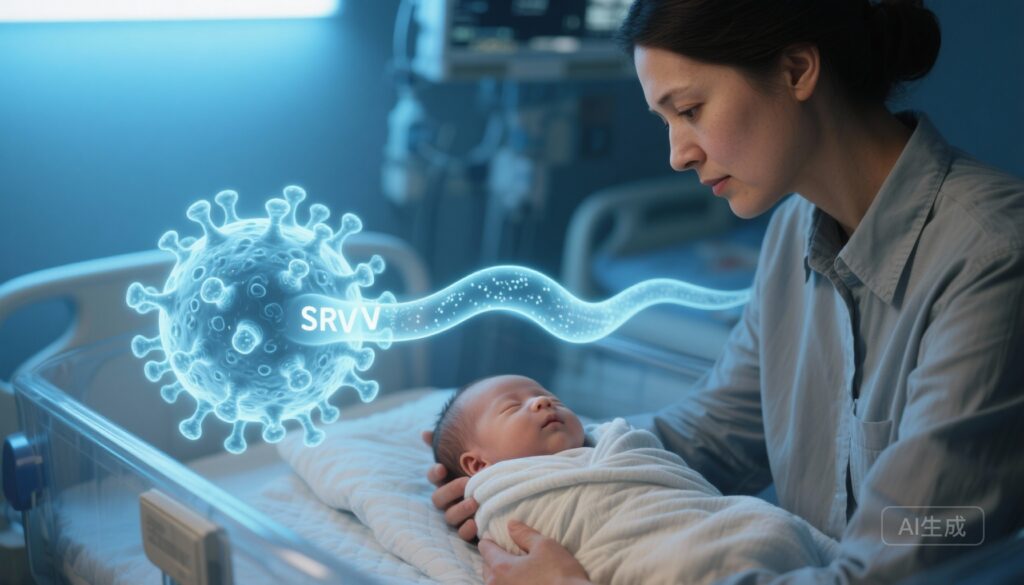Highlights
– In the MELODY phase 3 randomized trial, nirsevimab reduced RSV-associated medically attended lower respiratory tract infections (MA-LRTIs) and RSV coinfections in infants entering their first RSV season.
– No evidence was found for replacement of RSV infection by other respiratory viruses following nirsevimab immunization.
– Most RSV-associated LRTIs adjudicated in the trial were mild; hospitalization occurred in roughly one-quarter of single RSV infections.
Background: clinical context and unmet need
Respiratory syncytial virus (RSV) is a leading cause of acute lower respiratory tract infection (LRTI) in infants and a major driver of infant hospitalizations worldwide. Preventive strategies for RSV have historically been limited to palivizumab — used only in narrowly defined high‑risk infants because of cost and dosing frequency — and nonpharmacologic measures. Nirsevimab (formerly MEDI8897) is an extended half‑life, high‑potency monoclonal antibody directed at the RSV fusion protein that was developed to provide broad, single‑dose passive protection for all infants entering their first RSV season.
Study design: MELODY trial and post hoc pathogen analysis
MELODY was a randomized, double‑blind, placebo‑controlled phase 3 trial (2:1 randomization to nirsevimab vs placebo) that enrolled 3,012 healthy term and late‑preterm infants (gestational age ≥35 weeks) entering their first RSV season. The primary efficacy analyses demonstrated protection against RSV‑associated medically attended LRTI. The analysis summarized here is a post hoc, exploratory assessment of the etiologic causes of LRTI episodes observed during follow‑up through day 511 (approximately 17 months), with a focus on RSV and non‑RSV respiratory pathogens.
Key elements of the post hoc analysis:
- Population: participants from the full MELODY cohort who presented with an LRTI episode during the follow‑up window.
- Specimen collection: nasopharyngeal swabs obtained from infants at the time they presented with LRTI.
- Pathogen testing: comprehensive multiplex PCR using the BioFire Respiratory 2.1 Panel (22 pathogens tested, including RSV, rhinovirus/enterovirus, influenza, adenovirus, human metapneumovirus, parainfluenza viruses, coronaviruses, Mycoplasma pneumoniae, etc.).
- Endpoints: incidence of RSV and non‑RSV MA‑LRTIs (through day 511), coinfections with RSV and other viruses, and adjudicated severity including hospitalization.
Key findings and detailed results
Enrollment and sampling: 3,012 infants were randomized (nirsevimab n = 2,009; placebo n = 1,003). Among participants with LRTI episodes, 852 nasopharyngeal swabs were collected from 561 infants through day 511: 519 swabs from 337 infants in the nirsevimab arm and 333 swabs from 224 infants in the placebo arm.
Pathogen detection: RSV was detected in 193 of 852 swabs (reported as 22.7%). The report states that non‑RSV infections were detected in 55 of 852 swabs (reported as 64.7%); these numbers appear internally inconsistent (55/852 would be ~6.5%), so it is likely a typographic error in the original manuscript and the intended non‑RSV count was higher (e.g., 551/852 ≈ 64.7%). The interpretation below follows the authors’ conclusion that non‑RSV pathogens made up the majority of detected infections overall while RSV remained a substantial proportion.
Effect on RSV and RSV coinfections: The analysis found lower rates of RSV infections in the nirsevimab arm compared with placebo. This reduction included single‑pathogen RSV infections and RSV coinfections (notably RSV‑rhinovirus/enterovirus coinfections). Precise incidence rate reductions and confidence intervals are not reproduced here because the post hoc analysis primarily reported relative counts by treatment arm; the main trial publications provide the prespecified efficacy estimates.
Non‑RSV pathogen distribution: Rates of other non‑RSV respiratory viruses were similar between the nirsevimab and placebo arms. In other words, infants receiving nirsevimab did not have a higher relative frequency of non‑RSV respiratory pathogens as causes of MA‑LRTI, providing no signal of viral replacement at the individual level in this study.
Clinical severity and hospitalization: Approximately 70% of both single RSV infections and RSV coinfections were adjudicated as mild. Hospitalization was required in 26.2% of single RSV infections and 24.5% of RSV coinfections, indicating that coinfection did not substantially increase the proportion of cases that required inpatient care in this dataset.
Overall interpretation: Nirsevimab reduced RSV‑related LRTI burden in infants entering their first RSV season, including episodes in which RSV occurred with other respiratory viruses. The absence of increased non‑RSV MA‑LRTIs in recipients suggests that preventing RSV did not lead to immediate replacement by other viruses within the surveillance window of this study.
Expert commentary: biological plausibility, limitations and implications
Biological plausibility: Nirsevimab is designed to neutralize RSV by binding to a highly conserved epitope on the prefusion conformation of the RSV F protein, and its Fc region has been engineered to extend half‑life. These properties explain why a single intramuscular dose given before the RSV season is effective at reducing RSV infections through the high‑risk months.
Clinical and public health implications: If the observed reductions in RSV MA‑LRTI with nirsevimab are replicated in real‑world deployment, broader passive immunization of infants before their first RSV season could meaningfully reduce outpatient visits, hospitalizations, and associated healthcare utilization. The lack of evidence for viral replacement in this large randomized dataset is reassuring for short‑term population effects; however, ongoing surveillance post‑implementation will be essential to detect any longer‑term shifts in pathogen ecology.
Limitations of the analysis: Clinicians and policymakers should recognize several caveats.
- Post hoc, exploratory nature: this analysis was not the primary, prespecified endpoint of the trial. Results are hypothesis‑generating rather than definitive for secondary outcomes of pathogen ecology.
- Sampling bias: swabs were collected only from infants presenting with LRTI, so asymptomatic infections or mild infections not meeting the MA‑LRTI definition could be underrepresented.
- Potential reporting inconsistency: the publication contains an apparent numerical inconsistency in the counts/percentages for non‑RSV detections; readers should consult the full text or supplementary material for corrected tables or clarifications.
- Generalizability: MELODY enrolled healthy term and late‑preterm infants; findings may not fully extend to medically complex or extremely preterm infants, who were evaluated in separate trials and who have different baseline risks.
- Time window and ecology: the follow‑up captured the first RSV season and beyond to day 511, but longer surveillance is needed to assess multi‑year ecosystem effects and potential shifts in seasonality.
Comparative context: The effect of nirsevimab should be seen within the landscape of RSV preventive strategies. Palivizumab demonstrated efficacy in reducing RSV hospitalization among high‑risk infants (IMpact‑RSV), but its logistics and cost limited universal use. Nirsevimab’s extended half‑life and single‑dose regimen aim to overcome these barriers and broaden protection.
Conclusion and research/practice gaps
The post hoc analysis from MELODY supports that nirsevimab reduces RSV‑associated MA‑LRTIs and RSV coinfections in healthy term and late‑preterm infants, without detectable replacement of RSV by other respiratory pathogens within the observation period. These findings strengthen the rationale for considering nirsevimab as a seasonally administered, population‑level preventive option for infants entering their first RSV season.
Remaining questions include the long‑term ecological effects of broad passive immunization, impact in diverse geographic and socioeconomic settings, cost‑effectiveness compared with targeted strategies, and outcomes in medically vulnerable subpopulations. Continued post‑marketing surveillance and prospective studies will be needed to address these points and to confirm the absence of viral replacement over longer intervals and multiple seasons.
Funding and clinical trial registration
ClinicalTrials.gov: NCT03979313. Funding and detailed disclosures are provided in the primary publication; readers should consult the cited article for sponsor and conflict‑of‑interest statements.
References
1. Arbetter D, Gopalakrishnan V, Aksyuk AA, Ahani B, Chang Y, Dagan R, Esser MT, Hammitt LL, Mankad VS, Saez‑Llorens X, Shen D, Leach A, Kelly EJ, Villafana T, Wilkins D. Lower Respiratory Tract Infections Following Respiratory Syncytial Virus Monoclonal Antibody Nirsevimab Immunization Versus Placebo: Analysis From a Phase 3 Randomized Clinical Trial (MELODY). Clin Infect Dis. 2025 Oct 6;81(3):634-644. doi: 10.1093/cid/ciae596. PMID: 39656748; PMCID: PMC12497957.
2. The IMpact‑RSV Study Group. Palivizumab, a humanized respiratory syncytial virus monoclonal antibody, reduces hospitalization from RSV infection in high‑risk infants. Pediatrics. 1998;102(3 Pt 1):531–537.



